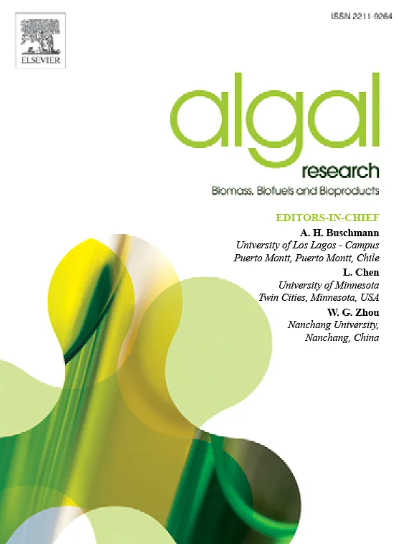aurantiochyum sp.通过提高高糖适应性促进多不饱和脂肪酸生物合成的适应性实验室进化机制
IF 4.6
2区 生物学
Q1 BIOTECHNOLOGY & APPLIED MICROBIOLOGY
Algal Research-Biomass Biofuels and Bioproducts
Pub Date : 2025-04-17
DOI:10.1016/j.algal.2025.104039
引用次数: 0
摘要
Aurantiochytrium sp. (Schizochytrium sp.)是一种海洋真菌样异养单细胞真核生物,用于生产多不饱和脂肪酸(PUFAs)。适应性实验室进化(ALE)是提高PUFAs产量的有效方法。经ALE高糖作用180 d,筛选到PUFAs高产的第20代进化菌株ALE- hg20。ALE-HG20菌株的总脂、二十碳五烯酸(EPA)和二十二碳六烯酸(DHA)产量在分批补料发酵中分别提高了15.51%、225.37%和52.67%。发酵动力学结果表明,ALE-HG20菌株总脂质和DHA的合成与细胞生长有解耦的趋势,而EPA的合成与细胞生长有加深耦合的趋势。转录组学分析显示,膜转运功能基因的上调导致葡萄糖的快速吸收,从而加速糖酵解途径,为PUFAs合成提供碳骨架。TCA途径代谢产物增加,但与TCA途径相关的氨基酸合成代谢减少,进一步促进了聚饱和脂肪酸合成途径。同时,PUFAs合成的前体代谢物显著增加。这也可能与ALE-HG20中糖酵解途径和PUFAs合成途径中GAPD和IS的蛋白质结构进化有关。GAPD和IS的活性口袋分别增加了10.36%和98.20%,氢键增加了11.76%和132.76%。本研究阐明了ALE对PUFAs合成的调控演化机制的变化。本文章由计算机程序翻译,如有差异,请以英文原文为准。

Mechanism of adaptive laboratory evolution for improving polyunsaturated fatty acid biosynthesis in Aurantiochytrium sp. through enhancing high-glucose adaptability
Aurantiochytrium sp. (Schizochytrium sp.) is a marine fungi-like heterotrophic single-celled eukaryote utilized for the production of polyunsaturated fatty acids (PUFAs). Adaptive Laboratory Evolution (ALE) is an effective method to improve PUFAs yield. The 20th generation evolutive strain (ALE-HG20) with high PUFAs yield was screened out after high-glucose of ALE for 180 days. The yields of total lipid, eicosapentaenoic acid (EPA) and docosahexaenoic acid (DHA) of ALE-HG20 strain increased by 15.51 %, 225.37 % and 52.67 % in fed-batch fermentation, respectively. Fermentation kinetics showed that the synthesis of total lipids and DHA had a tendency of uncoupling with cell growth in ALE-HG20 strain, while the synthesis of EPA had a tendency of deepening coupling with cell growth. Transcriptomic analysis revealed that the upregulation of membrane transport function genes led to rapid glucose absorption, thereby accelerating the glycolytic pathway to provide carbon skeleton for PUFAs synthesis. The metabolites of TCA pathway increased, but the amino acid anabolism associated with TCA pathway decreased, which further promoted the polysaturated fatty acid synthesis pathway. Meanwhile, the precursor metabolites of PUFAs synthesis were significantly increased. This might also be due to the protein structure evolution of GAPD and IS from glycolytic pathway and PUFAs synthesis pathway in ALE-HG20. The active pockets of GAPD and IS were increased by 10.36 % and 98.20 %, respectively, and hydrogen bonds were increased by 11.76 % and 132.76 %. This study clarified the change of regulated and evolved mechanism of PUFAs synthesis by ALE.
求助全文
通过发布文献求助,成功后即可免费获取论文全文。
去求助
来源期刊

Algal Research-Biomass Biofuels and Bioproducts
BIOTECHNOLOGY & APPLIED MICROBIOLOGY-
CiteScore
9.40
自引率
7.80%
发文量
332
期刊介绍:
Algal Research is an international phycology journal covering all areas of emerging technologies in algae biology, biomass production, cultivation, harvesting, extraction, bioproducts, biorefinery, engineering, and econometrics. Algae is defined to include cyanobacteria, microalgae, and protists and symbionts of interest in biotechnology. The journal publishes original research and reviews for the following scope: algal biology, including but not exclusive to: phylogeny, biodiversity, molecular traits, metabolic regulation, and genetic engineering, algal cultivation, e.g. phototrophic systems, heterotrophic systems, and mixotrophic systems, algal harvesting and extraction systems, biotechnology to convert algal biomass and components into biofuels and bioproducts, e.g., nutraceuticals, pharmaceuticals, animal feed, plastics, etc. algal products and their economic assessment
 求助内容:
求助内容: 应助结果提醒方式:
应助结果提醒方式:


